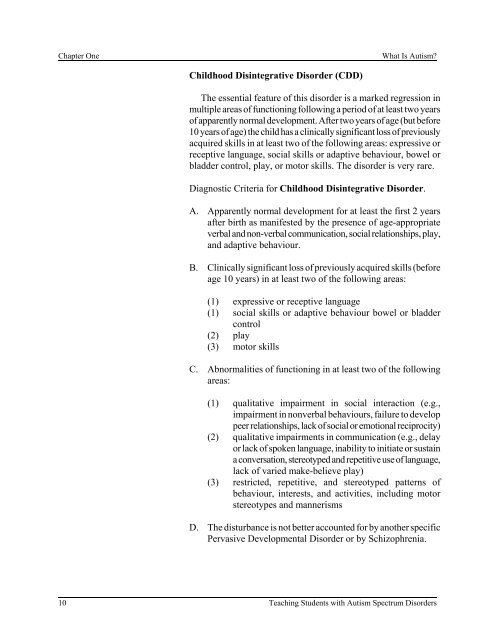Teaching Students with Autism Spectrum Disorders
Teaching Students with Autism Spectrum Disorders
Teaching Students with Autism Spectrum Disorders
You also want an ePaper? Increase the reach of your titles
YUMPU automatically turns print PDFs into web optimized ePapers that Google loves.
Chapter One What Is <strong>Autism</strong>?<br />
Childhood Disintegrative Disorder (CDD)<br />
The essential feature of this disorder is a marked regression in<br />
multiple areas of functioning following a period of at least two years<br />
of apparently normal development. After two years of age (but before<br />
10 years of age) the child has a clinically significant loss of previously<br />
acquired skills in at least two of the following areas: expressive or<br />
receptive language, social skills or adaptive behaviour, bowel or<br />
bladder control, play, or motor skills. The disorder is very rare.<br />
Diagnostic Criteria for Childhood Disintegrative Disorder.<br />
A. Apparently normal development for at least the first 2 years<br />
after birth as manifested by the presence of age-appropriate<br />
verbal and non-verbal communication, social relationships, play,<br />
and adaptive behaviour.<br />
B. Clinically significant loss of previously acquired skills (before<br />
age 10 years) in at least two of the following areas:<br />
(1) expressive or receptive language<br />
(1) social skills or adaptive behaviour bowel or bladder<br />
control<br />
(2) play<br />
(3) motor skills<br />
C. Abnormalities of functioning in at least two of the following<br />
areas:<br />
(1) qualitative impairment in social interaction (e.g.,<br />
impairment in nonverbal behaviours, failure to develop<br />
peer relationships, lack of social or emotional reciprocity)<br />
(2) qualitative impairments in communication (e.g., delay<br />
or lack of spoken language, inability to initiate or sustain<br />
a conversation, stereotyped and repetitive use of language,<br />
lack of varied make-believe play)<br />
(3) restricted, repetitive, and stereotyped patterns of<br />
behaviour, interests, and activities, including motor<br />
stereotypes and mannerisms<br />
D. The disturbance is not better accounted for by another specific<br />
Pervasive Developmental Disorder or by Schizophrenia.<br />
10 <strong>Teaching</strong> <strong>Students</strong> <strong>with</strong> <strong>Autism</strong> <strong>Spectrum</strong> <strong>Disorders</strong>

















